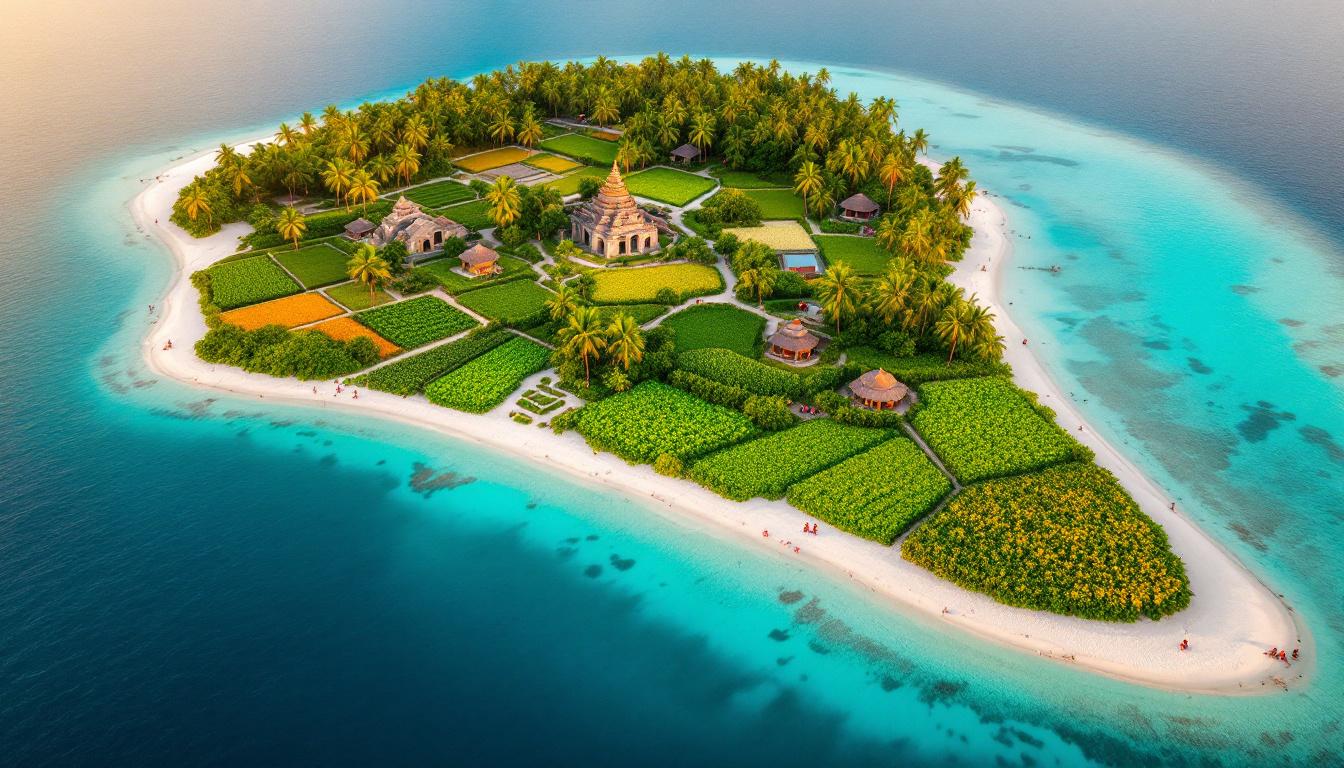Most travelers think the Maldives means luxury resorts scattered across blue lagoons. But tucked away in Alif Alif Atoll lies Thoddoo Island, barely 2 km² yet bursting with over 200 working farms. At just half the size of Central Park, this tiny agricultural powerhouse feeds much of the nation while keeping its village soul intact.
Local farmers call their home the “Basket of the Maldives” for good reason. Where other islands import everything, Thoddoo grows watermelons so sweet they’re reserved for Ramadan celebrations across the archipelago. The contrast hits you immediately—stepping off the speedboat onto an island where coconut palms share space with pumpkin patches rather than infinity pools.
With just 1,348 residents tending crops that supply Male’s markets, Thoddoo proves that tiny doesn’t mean insignificant. This island punches far above its weight, producing more fresh food per square kilometer than anywhere else in the Maldives.
The agricultural miracle that defies tropical stereotypes
Watermelon fields where resorts should be
Walking Thoddoo’s sandy paths reveals something extraordinary—22% of this tiny island is dedicated to farming. Bright green watermelon vines stretch toward azure horizons, their fruit destined for Male’s premium markets during Ramadan peak season. Local farmer Ahmed tends nearly one hectare of mixed crops, earning more from his betel leaf and chilies than many resort workers see in tips.
Ancient wisdom meets modern necessity
Each farming family receives 930 square meters per adult member over 18, a land allocation system unchanged for generations. This traditional approach means even tiny Thoddoo supports dozens of farming enterprises. Rain-fed irrigation and manual cultivation methods keep costs low while maintaining the island’s authentic agricultural character that locals fiercely protect.
Buddhist ruins hidden beneath tropical abundance
Seventh-century temples among the farms
Between the watermelon patches lie ancient Buddhist temple ruins dating back to the 7th century—a remarkable contrast to the Maldives’ Islamic identity. Stone carvings and monastery foundations emerge from the coral sand, telling stories of pre-Islamic civilization. These archaeological treasures, largely unknown to resort-hopping tourists, add profound historical depth to Thoddoo’s agricultural landscape.
Cultural layers preserved by isolation
The island’s remote location has protected both its Buddhist heritage and farming traditions. While other islands chase tourism development, Thoddoo’s residents maintain their agricultural economy, inadvertently preserving archaeological sites that might otherwise face development pressure. Walking these ancient grounds feels like discovering a secret chapter of Maldivian history.
Village life that tourism hasn’t touched
Authentic experiences money can’t buy elsewhere
Thoddoo’s 10 local restaurants serve curry made from vegetables grown meters away, not flown in from Sri Lanka. Guesthouses run by farming families offer genuine cultural immersion—helping with harvests, learning traditional fishing techniques, or joining evening conversations about sustainable agriculture. These authentic interactions remain impossible on resort islands focused on manufactured luxury.
Community rhythms unchanged by tourism
Despite welcoming visitors into its 200+ guesthouse rooms, Thoddoo operates on agricultural rhythms, not tourism schedules. Markets buzz with local produce trading, children walk through farms to school, and evening prayers echo over fields rather than hotel bars. This authentic village atmosphere creates intimate cultural connections that massive resorts simply cannot replicate.
The practical magic of visiting agricultural paradise
Getting there requires island dedication
Reaching Thoddoo means speedboat transfers from Rasdhoo after domestic flights from Male—a journey that filters out casual visitors while rewarding dedicated travelers. The extra effort creates an immediate sense of arrival somewhere special, where tourism supports rather than dominates local life.
Costs that shame resort pricing
A week exploring Thoddoo’s farms, ruins, and pristine beaches costs roughly $500-800 total—less than two nights at nearby luxury resorts. Fresh meals, comfortable guesthouses, and authentic experiences come at prices that reflect local agricultural economics rather than international tourism premiums.
This tiny island demonstrates that the Maldives’ most rewarding experiences aren’t found in overwater bungalows but in places where real life continues alongside natural beauty. Thoddoo’s 200+ farms prove that small islands can harbor enormous character.
Book direct with local guesthouses to support the agricultural families who’ve maintained this authentic paradise. Visit during dry season months for optimal farm access, and remember—you’re entering a working agricultural community that happens to welcome respectful visitors into their extraordinary tiny world.
Questions about visiting Thoddoo’s agricultural paradise
How do I arrange farm visits during my stay?
Most guesthouses facilitate farm introductions through their networks. Ask your host about visiting during harvest seasons or joining agricultural activities. Many farmers welcome respectful visitors, especially those interested in learning traditional Maldivian farming techniques.
What’s the best time to see Thoddoo’s agricultural peak?
Visit during March through May for watermelon harvest season coinciding with Ramadan demand, or July through September for diverse tropical fruit availability. Dry season months offer best access to both farms and Buddhist archaeological sites.
Are the Buddhist ruins accessible to tourists?
Yes, though they’re unmarked and require local guidance. Ask guesthouse hosts about the 7th-century temple sites hidden among agricultural areas. Respect for these ancient spaces is essential—they’re important cultural heritage sites protected by the farming community.
